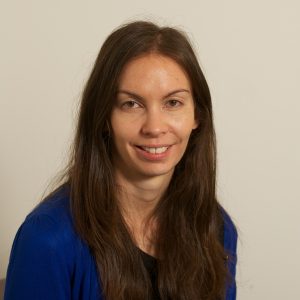Meet the Speaker – Jen Pestana

DR JEN PESTANA
University of Strathclyde, Glasgow
QUT alumni and University of Strathclyde lecturer, Dr Jen Pestana takes five to talk about the challenges in her field and why taking a summer school during her PhD was one of the best things for her career.
1. Can you tell us about your work? What drives your interest in this field?
I work on iterative methods for solving linear systems. These methods generate a sequence of approximations to the solution of a linear system, and so the key challenge is to ensure that this sequence converges quickly to the exact solution, or a good approximation to it. To achieve this, I try to understand the structure of the linear system, and use knowledge of the problem from which it arises.
I like the variety that comes from working on iterative methods: each problem presents new challenges and opportunities. I also like the mix of computing and theory that comes with numerical analysis research.
2. What are the most interesting “big questions” or challenges facing researchers in your area?
Traditionally, many of the linear systems in my area came from mathematical models of physical processes, e.g., fluid flow or solid mechanics. We now have sophisticated tools that we can use when working with these problems. However, there are many new applications in, e.g., social sciences, economics and statistics, that require iterative methods. Developing suitable tools and solvers for these problems remains a challenge.
Even for linear systems coming from physical systems there are questions about the best way to solve them. New approaches, involving matrix equations and tensors, are proving promising but there is still a lot to understand about how they work, and ways to improve current methods.
3. What are your favourite applications of your work?
A lot of my work is on problems from fluid flow, particularly on the Stokes equations which can be used to model viscous fluids like lava and blood. More recently, I’ve become interested in fractional diffusion equations, which describe anomalous diffusion (that doesn’t come from Brownian motion). Such equations have wide applicability in elasticity, fluid flow in porous media, image processing, finance….
As a side project, I’m also working with electrical engineers on broadband signal processing problems, such as trying to separate unknown signals that are picked up by receivers (blind source separation). This has been a lot of fun, and I’ve learnt new things about maths and engineering!
4. Why did you become a mathematician?
In my final year of high school I studied a first-year calculus subject at QUT and loved it, so I knew I wanted to study science. I started a physics degree, but soon realised that I liked the maths much more than the physics, so I switched to a Bachelor of Mathematics. I never planned the rest of my career, but took interesting opportunities when they arose, and applied for positions I didn’t think I would get!
5. Do you have any advice for future researchers?
A couple of things that helped me were to stay open to opportunities, and to get to know people in maths and stats, and in other disciplines. Chatting with people is handy for getting advice or a new perspective, but more importantly it’s a great way to make friends.
6. Deepening field knowledge and providing a networking platform, why are opportunities such as AMSI Winter School so valuable? What do you hope attendees take from your lectures?
I went to a summer school during my PhD and it was one of the best experiences of my career. Seeing and understanding new mathematics helped me to become a better mathematician, and over the years I’ve used a surprising number of things I learnt at the school. Having a broader knowledge of maths also comes in handy when meeting researchers and at conference/seminar talks.
Perhaps more importantly, I still keep in touch with a number of people from the summer school. We’ve worked on research projects together, and I often ask them for advice. I also really enjoyed meeting the lecturers in a less formal environment.
I’d love for attendees of my lectures to see connections between different stages of the numerical solution process, and to pick up things that may help them in their own research at some point in the future.
Dr Jen Pestana will be presenting the topic Numerical methods for Stokes flow at the 2019 Winter School at Queensland University of Technology this July

